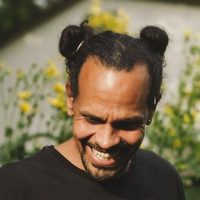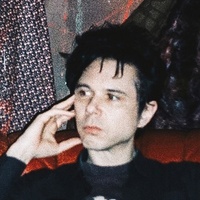On the infinite possibilities of landscape
Prelude
Allison Janae Hamilton is a visual artist working in sculpture, installation, photography, and video. She was born in Kentucky, raised in Florida, and her maternal family’s farm and homestead lies in the rural flatlands of western Tennessee. Hamilton’s relationship with these locations forms the cornerstone of her artwork, particularly her interest in landscape. Using plant matter, layered imagery, complex sounds, and animal remains, Hamilton creates immersive spaces that consider the ways that the American landscape contributes to our ideas of “Americana” and social relationships to space in the face of a changing climate, particularly within the rural American south. This year she has a show, MOOD, on view at MoMA PS1 and another show, Tricknology, opening at Marianne Boesky Aspen.
Conversation
On the infinite possibilities of landscape
Visual artist Allison Janae Hamilton discusses the evolution of her creative practice, working with landscape as a medium, involving your own family in your work, and the divide between rural and urban areas.
As told to T. Cole Rachel, 2921 words.
Tags: Art, Beginnings, Inspiration, Focus, Politics, Collaboration.
I know I’m catchng you at a busy time. Are you a pretty voracious multi-tasker? Are you currently juggling a variety of pieces and projects?
Yeah. Sometimes something just has to get done, you know? And that’s the best motivator. You need to turn it in or have an edited version finished, if it’s a video. Sometimes something just needs to be done at a certain time, and you just have to crank it out. It’s also nice when you have a little bit more time to structure things based on where your head’s at or how you’re feeling. So much depends on the energy of your week, of your day, of your body. There are just so many different things at play.
I work across multiple types of media. So sometimes I’m at a desk editing a video, and sometimes I’m doing really physical labor working on a sculpture, or something that’s larger-scale. It just kind of depends. If I have multiple projects that are all far out deadline-wise, I have the luxury to work on what feels it will be the most productive to do that day. But you know, sometimes things just have to get done, and you just get into that mode.
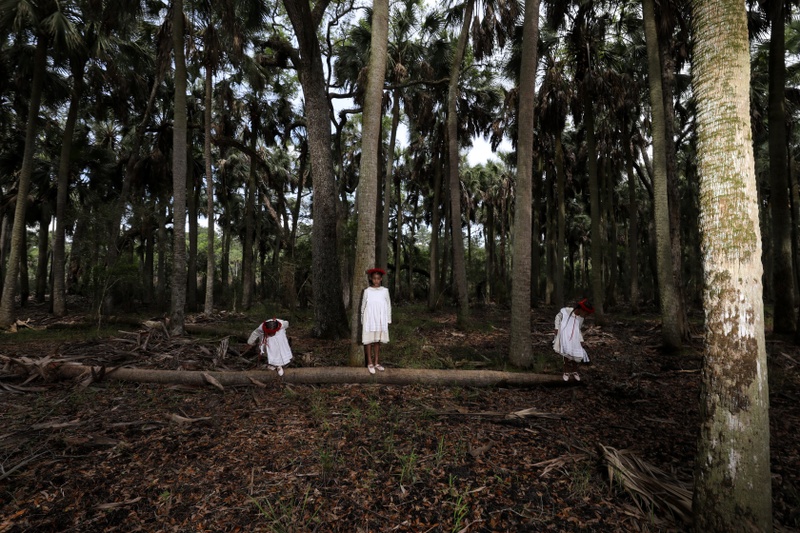
Three girls in sabal palm forest II, 2019 Archival Pigment Print 24 x 36” Ed. 5 + 2AP Courtesy of the artist
Honestly, it’s all exciting to me. It all brings out different motivations, and it can propel you in different ways. Sometimes, when you are working with a short time crunch, interesting, exciting, surprising things can happen. Or maybe something goes wrong, but then it will actually open up an interesting idea. Then you keep going along that path. So the methods of how you work can bring about really surprising elements.
Did you always work across disciplines? Your work really does involve a lot of different creative practices.
No. Really early on, I considered myself a photographer, more than anything. That was always my first media, my first art form. It was kind of a slow development, because I started off doing a lot of landscape photography. Then I went into environmental portraits, but eventually I would make these elaborate costumes and props and things to be a part of the portraits. After I started showing them, eventually I might include a prop or something that one of the characters in a portrait might have been holding, and I’d bring it out into the exhibition space to show alongside the photos. Still, at the time, it was almost tangential to, or parallel with, the photographs. It still wasn’t really its own thing.
Then it just kept growing and growing from there. The objects became a bigger part of things with their own merit. They were no longer just supplementing the photographs, they were part and parcel with them in telling this long, epic story. The objects became more totemic.
Now, the work is kind of 50/50. It’s kind of half images, whether that’s photo or video, and half objects and sculpture and installation/immersive environments. It really all works together. Sometimes I’ll present a sculpture on its own, or photos on their own and sometimes I’ll put them all together in an immersive type of space. Now it’s all of the above. But no, it didn’t start out that way. I started with photography first.
Your work is largely about the landscape that you grew up in. Where did that fascination come from? Has that always been the primary subject of your work?
It was something that developed pretty early on. I grew up in Florida, but my mom’s side of the family is from rural western Tennessee, and we have our big family farm out there. When I was a kid growing up in Florida, we would go several times a year to help with different harvest seasons, or planting seasons out on the farm. I was around 12 or 13, middle-school age, and I was part of a magnet program where I studied photography. We’d have these different assignments and I would complete a lot of them when I would go home to the farm. I made a lot of landscape, 35-millimeter, black-and-white photos.
Even then I noticed a lot of changes that were happening around the farms. Maybe we would have to demolish a certain structure or a barn or something like that, so I would photograph it. I really felt at an early age that it was important to document the land and the region, and keep track of some of the changes that I saw going on. That seed of interest was planted at an early age.
Now I really am looking at a very specific set of landscapes, which are the landscapes that I know most intimately. Either Florida, where I’m from, or Tennessee, where my maternal family’s roots are, or the Carolinas, which is where my dad’s side is from. Also Kentucky, where I was born. Still, I’m most often drawing from that north Florida Gulf region.

The peo-ple cried mer-cy in the storm, 2018. Tambourines and steel armature From the exhibition Indicators: Artists On Climate Change. On view at Storm King Art Center through November 2018. Photo credit: Jerry Thompson
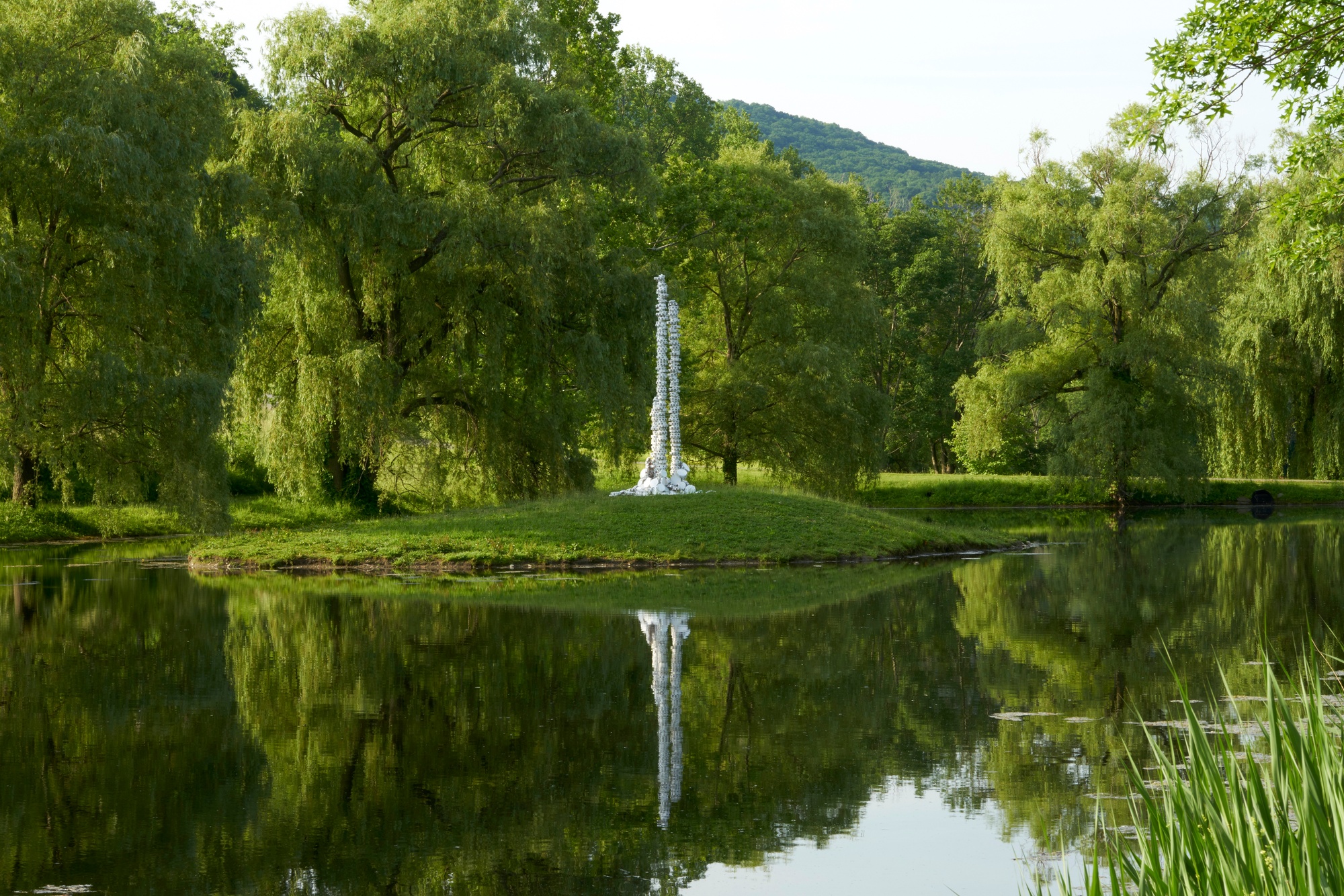
Through the specificity of using the landscapes that I know best, and really looking at the storyline and the history of that landscape, you really can draw parallels and see patterns that are happening all over the world. You can see the way that land is part of a region’s history, or how it really drives a region’s history. You see evidence of the power dynamics and the way that natural disasters can devolve into social disasters, or they illuminate the already-existing social disasters that are already there.
I find that the more specific I get with looking at the landscapes that I grew up with and that I know, other people will look at the work and find parallels that they can recognize in their own home regions, wherever that might be around the world. My work is really a story in which landscape is the main character, rather than a background in our lives. You see the way that it’s been wielded by power structures, whether that’s government or things like that, and how people are displaced. You see how people who may have been exploited or marginalized in some way use land through their spiritual practice, as a place of respite, refuge, and hope.
So it’s these two sides of the same coin—a lot of the work is very dark and haunting, speaking towards history. There are these specific types of labor that are connected to the land, these very difficult stories that are intertwined with the history of land and place, but also all of this imagery that feels very calming, and really pleasant and beautiful. The work also speaks to the way that landscape can function in that way, on a spiritual level.
Your work is very tied up with the history of your own family—and they also sometimes appear in the work in various ways. What do they make of it?
They are really starting to enjoy participating in it. It’s kind of like they are now putting their own creativity into it. For example, my mom started out participating in the work just because I asked her to, and she wanted to support the work. But now, she’s really getting into it in her own right. She thinks that the storyline and the concerns that the work brings out are really important, as someone who was born and raised on our farm. Having seen the overall arc of the body of work, and having participated in multiple projects now, she’s really invested from her own perspective, rather than just supporting me in my project.
That’s been really interesting to see, to witness them stepping back from the work and looking at it from the point of view of an observer, to consider their own long histories. Making the artwork has brought a lot out in them, and they’re able to connect experiences they had growing up to some of the larger concerns, especially dealing with the environment and climate and things like that. We start talking about the work and we always have some really interesting, engaging conversations about the concepts and the topics that the work stems from. So it’s been really fruitful in that way. It has made me feel closer to them and to where I come from.
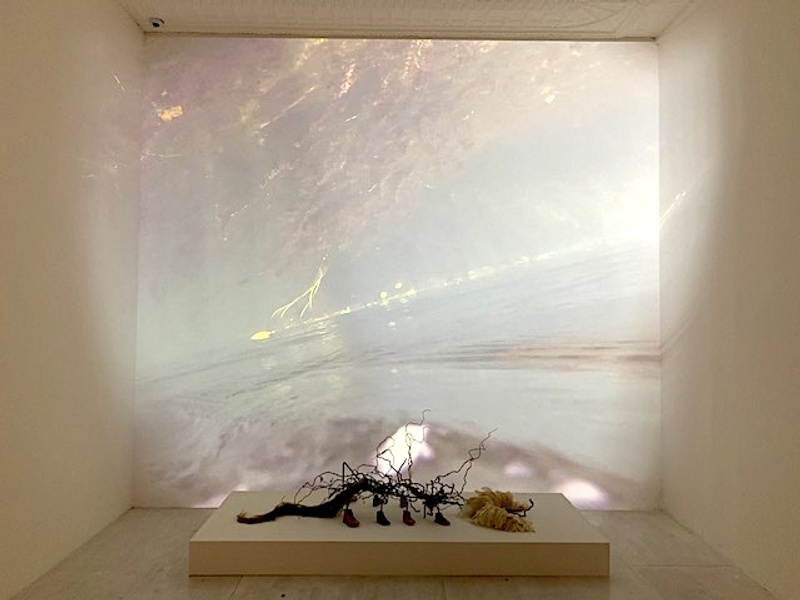
Blackwater Creature II, 2019 Mixed media.(Feathers, wood, hair, resin, metal) 90(L) x 62(W) x 13(H) Unique. From the exhibition MOOD: Studio Museum Artist-in-Residence 2018-2019. On view at MoMA PS1 through September 2019
You live in NYC but spend a lot of time back in the places you grew up making the work. Do you find that it’s important to have that distance in order to have a better perspective on it? They say you can’t ever really understand the place you grew up until you move away from it.
Yeah. That’s been my experience. I don’t think I realized how much the American South really shaped my outlook, or how much I truly experienced the land there. As a kid I spent tons and tons of time outside. So much of my experience of growing up is tied to the landscape, so I think coming here and moving to the city really just heightened my awareness of how much all of that influenced me.
I go home a lot. I go back a lot now to make the work, because I don’t think that I can make the work effectively if I do it all from here. So I go home several times out of the year, and stay for a certain period of time, to really sink into the life there. As the seasons shift and change, and the place shifts and changes over a longer period of time, it’s important for me to be there as much as I can. I’m always going back and forth.
Could you see yourself living there again?
Oh yeah, for sure. Yeah. I think eventually, maybe in a few years, I’ll become a snowbird. That is what we call it in Florida—people who fly down during the winter. I might do that, because there are a lot of other types of projects that I want to invest my time and energy in out there. I also want to work with my home communities in a positive way.
I do see myself spending more and more time there, hopefully being able to continue going back and forth. I love being in New York City as well. It’s also been important for me to be able to be here, to connect and have a community of artists around me, and to also be engaged in the dialog from the perspective of being here. I’m happy to be able to experience so much diversity of form, and to see so many different types of work that my friends and colleagues are engaged with.
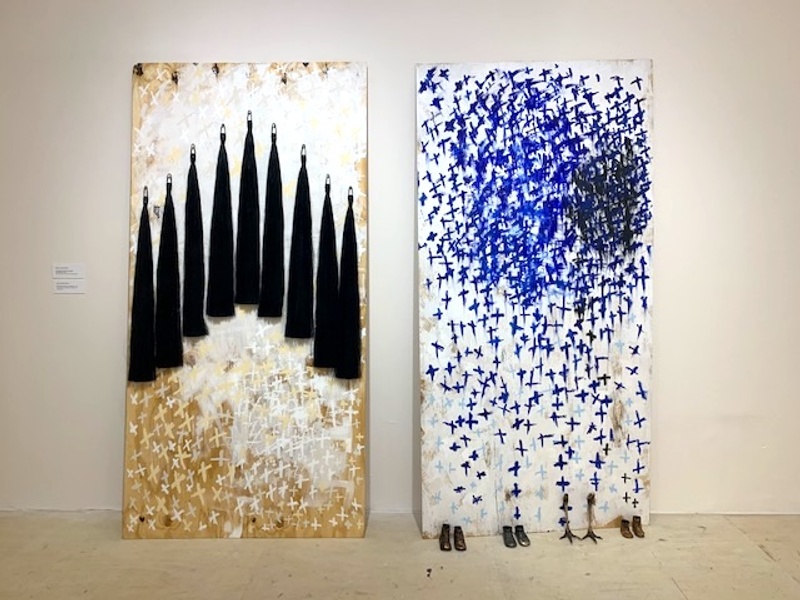
Yard Sign with Yellow and White Constellation, 2019.Mixed media on wood panel 72 x 48” Unique. Yard Sign with Blue Constellation, 2019 Mixed media on wood panel 72 x 47” Unique. From the exhibition MOOD: Studio Museum Artist-in-Residence 2018-2019. On view at MoMA PS1 through September 2019
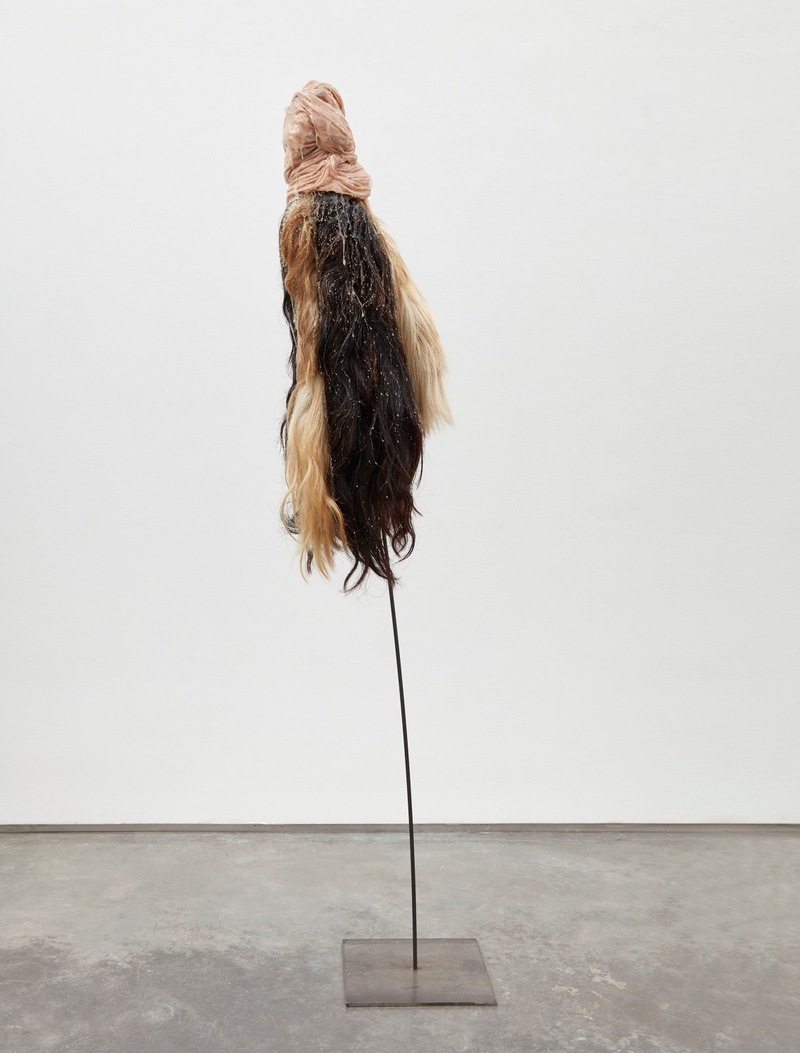
Blackwater Creature III, 2019. Mixed media (Fabric, hair, resin, metal); (H), base: 11 x 11, hair: 14; (W) Unique. From the exhibition Tricknology . On view at Marianne Boesky Gallery through September 2019. Photo credit: Jason Wyche
Looking at your body of work is also an amazing history lesson. I would never have known about the history of the turpentine industry in Florida, for example, or how that plays into the landscape and the culture there.
Thank you. Yes, the turpentine industry in Florida was once the second-largest industry behind citrus. That’s a big part of our history, but it’s one that’s not really recognized or talked about that much. It was this really brutal process of labor, one of those things that developed right on the heels of American slavery, where people joined a company but immediately when you join, you’re in debt to the company forever. You have to pay for these cabins in the turpentine woods that you would live in. You’re in debt immediately for the clothes that you’re wearing and things like that, so you’re constantly trying to pay back before you even earn a wage. And when you do earn a wage, you’re paid in this company currency that you can only spend back at the company store. It was kind of a de facto slavery system that continued for many, many decades. And yeah, it’s not something that people really remember. It’s not part of the history we’re taught. Even growing up in Florida, I never remember learning about that part of Florida’s history in school or anything.
This history and these landscapes seem like almost infinite subject matter. Do you imagine a point when you’ll feel like you’ve exhausted this, or when you might want to do something totally different? Do you ever feel any kind of pressure around that?
I guess we’ll see. For now, there’s so much that I keep coming across—things I didn’t know, or stories that are important to tell, regarding the landscape in general. Right now I feel like I have a lot of material to work with, especially because often the conversations around things like climate change or the environment are seen as coastal issues. They are seen as things that only people in New York or LA really care about, which is simply not true. Growing up in a farming family, especially with my older aunts and uncles, this was always part of the conversation.
These are not really the people who are at the forefront, at least in terms of media perception. These are not the people who are seen as part of the conversation. So if anything, I’m also appreciative that the work can shed some light on that. So yes, there are just so many different topics that fall under this umbrella. There is so much to work with.
As someone who also grew up on a farm—in my case, Oklahoma—and now lives in New York City, I understand what you mean. I feel like people who have never lived in any part of the country that wasn’t the East or the West Coast, often just have no concept of what the rest of the country is like. Or that there are people who experience these same kinds of concerns in very different ways.
Yeah. Absolutely. And it also often has to do with race. It’s coded in different ways. The word “urban” is now almost synonymous for Black. And you know, most of this country is actually rural. Blackness for me, at least as I experienced it my whole life until I moved to New York City at the age of 22, was kind of rural and suburban. So how does this term that really just means “city” or “metro,” how does that become racialized, in the same way that the part of the country where my family’s from is called Trump country? My family is not necessarily representative of the Trump voter, but they have, for generations and generations and generations, lived in that region. So how are these things coded in this way? How did certain regions become categorized, in ways that are not necessarily completely accurate? That’s another thing that’s influenced my work.
Post-migration, there are still tons and tons of African-American folks living in the South, in the rural parts of the South, too. But the way these kind of discourses are organized and structured really leaves a lot of people out, I think. There are still so many stories, so many kinds of experiences, that people still don’t know anything about. I feel both obligated and honored to try and tell them.
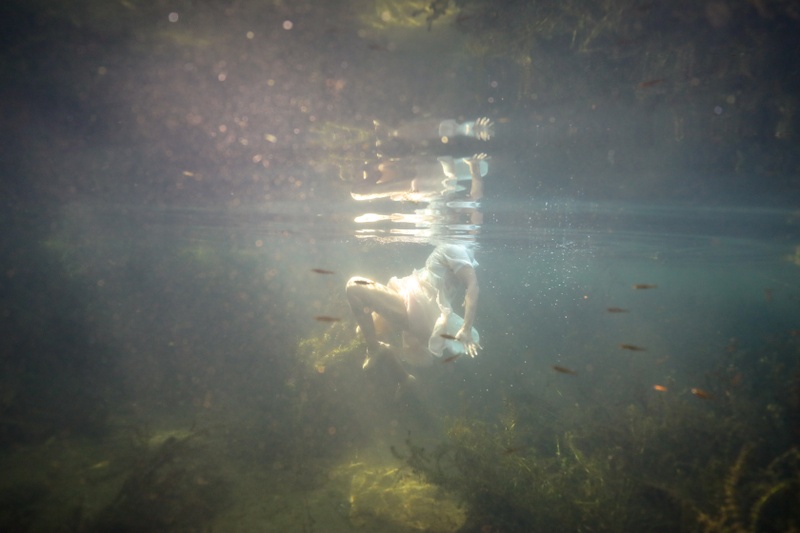
Floridawater I, 2019. Archival Pigment Print 24 x 36 Ed. 5 + 2AP. Courtesy of the artist
Allison Janae Hamilton Recommends:
Freshwater, a novel by Akwaeke Emezi
Florida, collected stories by Lauren Groff
George Clinton happens to live in north Florida, not too far away from my family. I always recommend his music as something good to listen to in the studio.
Music, in general, is a big part of how I work. If I’m working at my desk or editing or something like that, I listen to something that I can kind of zone out to—maybe just atmospheric music, or house, or electronic stuff sometimes. But if I’m making sculpture or painting and really working on things, I’ll probably listen to something with more rhythm, like drum and bass. It’s good to experiment with soundtracking your space. It’s amazing how much that can affect the rhythm of your day and the pace of your work.
- Name
- Allison Janae Hamilton
- Vocation
- Visual artist
Some Things
Pagination
